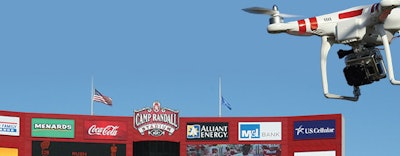
Marc Lovicott, public information officer for the University of Wisconsin, never misses a home football game. But recovering from knee surgery, he was forced to watch from home as the Badgers battled the University of Illinois at Camp Randall Stadium on October 11, 2014. The game made national news, but not for the 38-28 Badgers victory. Rather, it was for what happened between the third and fourth quarters — during the "Jump Around" tradition — when an unmanned aircraft was spotted hovering over the student section.
Lovicott admits that unmanned aircraft were a safety concern that had been discussed but not one for which the university steadfastly prepared. "Pre-October 11, it was on our minds. We had discussed what we do if something like that happened, but it really was on the back burner because it wasn't something we had dealt with before or felt we would need to deal with. Now, we have a policy in place."
The University of Wisconsin's approach to unmanned aerial systems is a common one nationwide — sports security managers recognize that this increasingly popular technology is a potential threat, but consider it something that will not directly impact their venue or event.
And while the pilot's intentions in the case of Wisconsin were likely harmless — "Jump Around" is a popular gameday tradition at Camp Randall, especially in the student section — it doesn't necessarily mean the next pilot's intentions will be. "If somebody can fly a small camera into a stadium, what else can they carry along with it?" wonders Lovicott.
Unmanned aerial systems pose a legitimate threat to sporting events in America. These devices are not only becoming cheaper and easier to own, but technology has advanced to such a point that virtually anyone — hobbyist or terrorist — can fly one.
"It's a video game now; it's not as complicated as it used to be, and it takes nothing more than a laptop or tablet with a joystick to fly one," says Ray DiNunzio, director of strategic security with the National Football League.
Even those amateur pilots with good intentions can pose a safety threat to athletes and spectators. "What if a gust of wind came or the pilot lost control and took this thing down into the players or spectators? There are a number of aspects associated with public safety that we worry about," Lovicott says.
So what can be done to protect your sporting event against these looming threats?
TAKING FLIGHT
"One of the things about drones that concerns people is that it is difficult to stop something that is airborne," says Danny DeLorenzi, director of security for MetLife Stadium. DeLorenzi has only had one incident at MetLife, where there is signage strictly prohibiting the use of drones on the property. In that one case, state police officers who were in elevated positions saw the device as soon as it took off, and within minutes, the situation was under control. "You have to come up with the rule first to tell someone to stop doing it," DeLorenzi says.
Last fall, the Federal Aviation Administration updated its rules to more clearly prohibit drone flights over stadiums that hold more than 30,000 people. At Arizona Stadium, for example, unmanned aerial systems now must stay above 3,000 feet within three miles of a stadium from one hour before game time until one hour after, with violators risking federal criminal prosecution.
While that rule may address outdoor stadiums, what about endurance events that are spread across many miles? Coincidentally, last year's Ironman Triathlon World Championships, which span 140 miles in Kona, Hawaii, were sponsored by GoPro, a line of portable action cameras commonly associated with drones.
"With that partnership came the realization that we might experience an abnormally high amount of unmanned aerial vehicles above the event," says John Bertsch, manager of public safety and emergency management for the Ironman World Championships. Putting even more pressure of Bertsch was an incident that occurred approximately six months earlier when a drone operator lost control of a device that was filming a triathlon in Australia, injuring competitor Raija Ogden mere meters from the finish line.
With reports of increased drone activity around the host hotel and primary venue areas, Bertsch and his team made the decision to ban drones over the immediate airspace — the lone exception was NBC's authorized unmanned aerial vehicle. Eight hours into the race, the first male finisher was approaching when Bertsch got a call.
"Reported UAV hovering 200 yards south of the finish line over the racecourse and a few thousand spectators who have lined the chute," Bertsch recalls. "Our deployment team activates, but it is quickly determined not to be hostile, so they stand down while security personnel try to find the pilot, which is not easy in a crowd. The pilot could be a half-mile away, but the crowd turns out to be the best resource, as most of them can point to the origin of flight. A few minutes later, the pilot was identified, and he voluntarily cooperated, landing his UAV."
FLIGHT CLUBBED
Currently the FAA and Department of Homeland Security are working on technology that can be used as a better defense against unmanned aerial systems, and the NFL is working with both federal agencies to ensure the safest environment possible at each stadium through these technologies. "For the short-term, we have established policies that prohibit these devices from our stadiums on gameday, but for the long-term, we're working with the federal sector on those latest technologies, and tracking what the government is doing in terms of research and development to ensure we have the technology to be able to defend against these devices," says DiNunzio.
In addition to technology, it is critical to have the proper protocols in place. The new drone policies at the University of Wisconsin dictate when play should be stopped and how to go about locating the pilot, for example. Security and medical staff members are tasked with scanning the skies on top of their normal duties. "We're much more vigilant now," Lovicott admits. "We knew this problem existed based on other stadiums across the country, but until it happens to you, you don't really start taking notice."
Indeed, drones have become a global phenomenon. A 2016 European Championship qualifying soccer match between Serbia and Albania ended abruptly last fall when a drone flying the Albanian flag started a fight between fans on the pitch, requiring action from hundreds of riot police. But cameras and banners aren't the biggest concerns now facing public safety professionals.
"If someone were to weaponize one of these devices and use it to cause harm, early detection and a response program to deal with the aftermath isn't going to prevent it from happening," adds DiNunzio. "We have to establish a way to defeat these devices, thwart the flight path and prevent them from getting into the stadium."
Sound Advice
Sports security professionals have been aware of the safety and security problems associated with drones for quite some time. But the potential impact drone attacks can have on sporting event safety has rapidly progressed. While security professionals are focusing on drones as they relate to security and privacy concerns, drones' impact on the future of event security remains unclear.
What is the best method to ward off drones? Drones produce a signature sound when they're flying, and microphones can be used to listen and detect ambient sounds. The signature drone sound can be tracked against a database of known stadium signatures and a text can be sent to the stadium's emergency response team, supervisors and command center warning that a drone is approaching the stadium perimeter.
Paired with an incident management system, a drone detection solution can enhance overall awareness. Knowing where drone hot spots exist is the first step toward implementing appropriate detection and response measures.
Jacob Molz is chief communications officer with Coral Springs, Fla.-based ISS 24/7, a venue management software provider.
This article originally appeared in the Winter 2015 issue of Gameday Security with the title "Game of Drones."
































